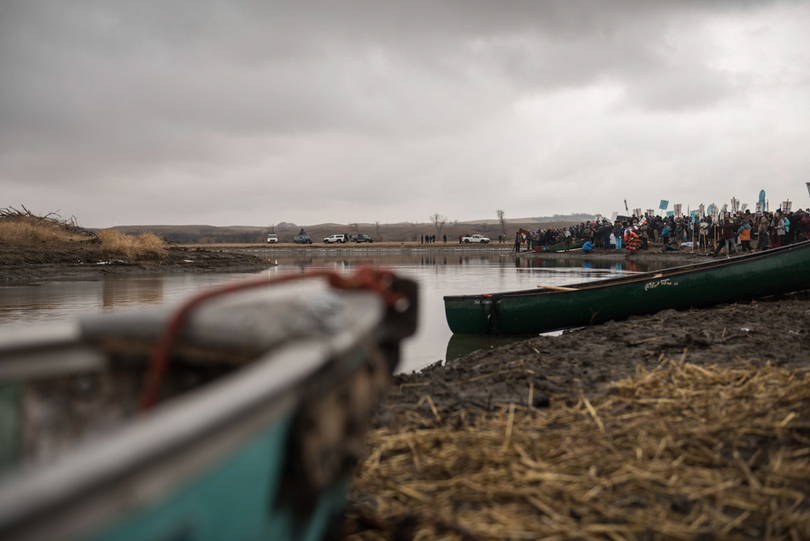Environmentalists and indigenous rights advocates at SUNY-ESF unite against completion of the Dakota Access Pipeline

Frankie Prijatel | Senior Staff Photographer
Water protectors at Standing Rock wait along the right bank of the river to peacefully travel across to say communal prayers Thanksgiving Day.
Professors at SUNY-ESF have said they share Native Americans’ concerns regarding the completion of the controversial Dakota Access Pipeline.
Despite longstanding opposition from protesters and environmentalists, President Donald Trump signed executive actions on Jan. 24 to advance completion of the pipeline that some say could contaminate the drinking water of over 8,000 indigenous people who live on the Standing Rock Indian Reservation.
“There is no life without water,” said Jack Manno, an environmental studies professor at the State University of New York College of Environmental Science and Forestry. “That’s why when NASA looks out at all the stars and planets to see if there’s life, what they’re looking for is signs of water. The sacredness of that connection is so very powerful, and it’s a teaching that native people have been giving us.”
The 1,172-mile pipeline will carry an estimated 470,000 barrels of crude oil through a proposed route under Lake Oahe in North Dakota every day, less than half a mile from the Standing Rock Indian Reservation. The Obama administration previously denied the final easement necessary for construction last December.
Manno attended the United Nations Conference on Environment and Development in 1992 — a conference that inspired the creation of the seminal Kyoto Protocol, an international treaty with member states pledging to curb carbon emissions. He stressed that he thinks the threat to native sovereignty by the Dakota Access Pipeline is just as urgent as the threat posed to the environment.
“If we’re going to make up for anything in our history, we ought to be standing with the native people who are telling us to pay attention to the fact that water is life,” he said. “It does matter that we resist the pipeline because of global warming, but what’s really important is the changing of our mindset.”
The Center for Native Peoples and the Environment at SUNY-ESF has been creating programs that use diversity, research and education to intertwine the ecological stewardship of indigenous practices with scientific knowledge of the collegiate community, to work toward goals of sustainability.
Neil Patterson, assistant director of the center, said he helps in this mission by bringing the message of the local Onondaga people to the student body at SUNY-ESF. Patterson said he was disappointed but not surprised with Trump’s decision to complete the Dakota Access Pipeline.
“This is the most recent event in a long history of energy projects that essentially ignore indigenous peoples’ concerns for the environment and their own self-determination,” Patterson said.
Though crude oil pipelines tend to have less spills when compared to trucks that carry oil — they are around 70 times more dependable as road transportation, according to data gathered by the Manhattan Institute think tank — the results of a break underground with an oil pipeline are typically more catastrophic in scale. The probability of a pipeline’s leak or rupture only increases with age, and ProPublica reports that over half of the United States’ 2.5 million miles of pipeline are at least 50 years old.
On the SUNY-ESF campus, efforts to resist projects like the Dakota Access Pipeline motivate environmentalists and indigenous advocates alike to work together, Patterson said.
“It’s a really beautiful symbiosis in a way,” Patterson said. “We have students who just want to protect Mother Earth and students who want to follow the lead of indigenous communities. It just happens that this particular event is the culmination of those two concepts.”




